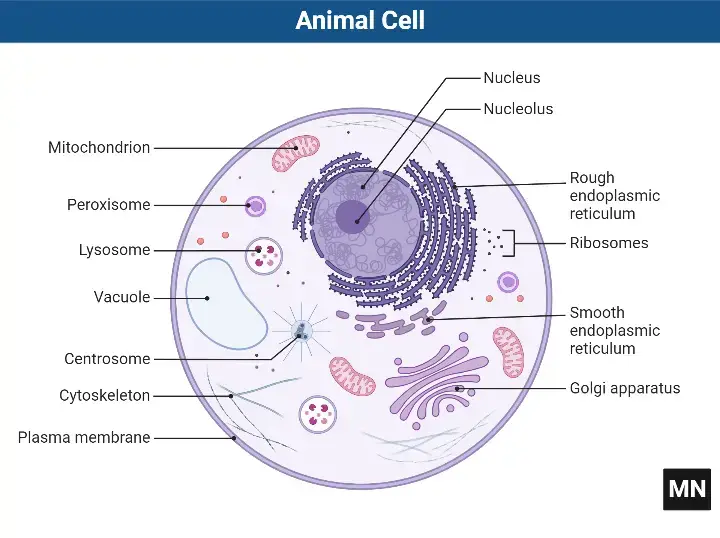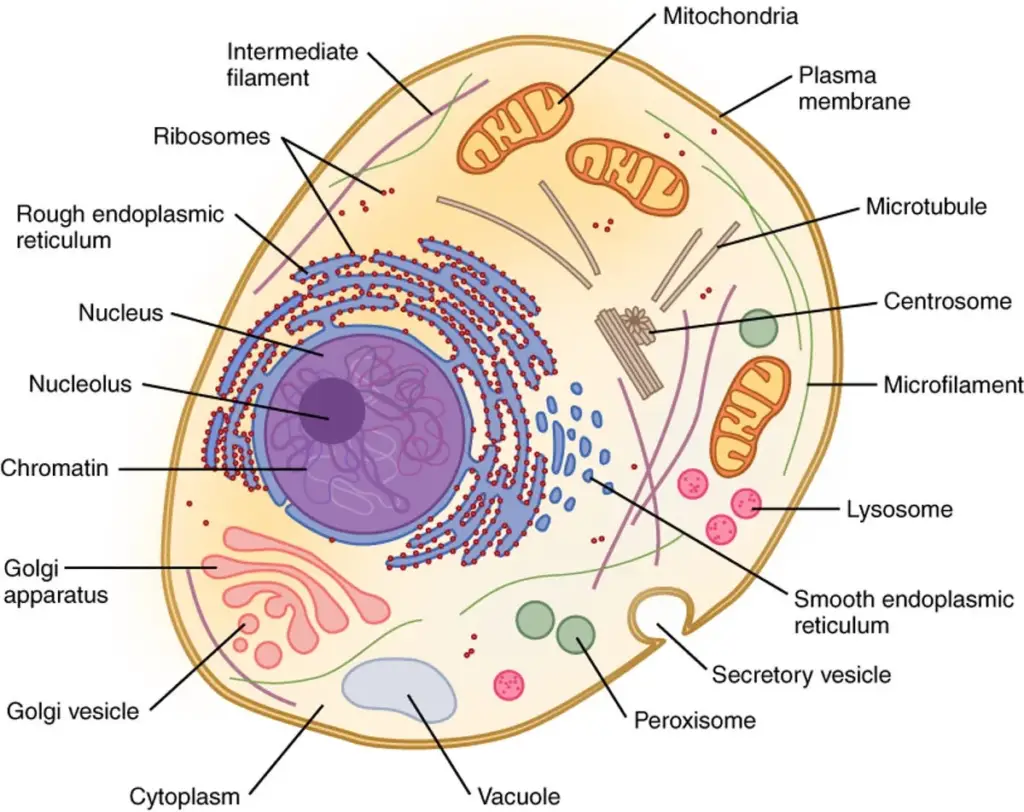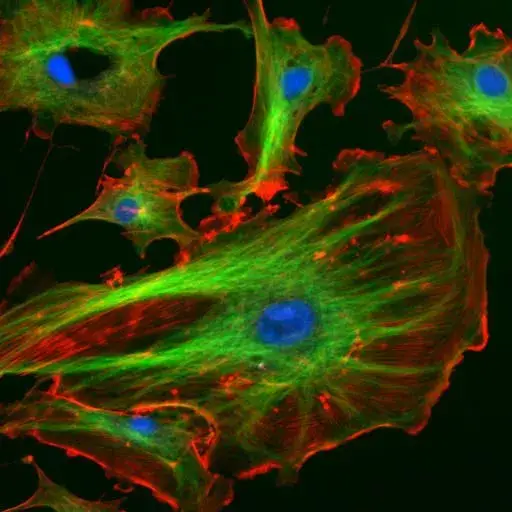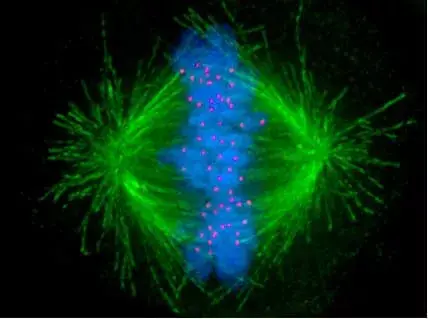Robert Hooke, an English scientist, observed the fundamental unit of life with his crude compound microscope in 1665. He developed the term “cell,” which is derived from the Latin word “Cella,” which refers to small chambers.
Subsequently, several scientists contributed to Robert Hooke’s discoveries, and the Cell Theory was eventually proposed. As technology has advanced, new and revised tenets have been incorporated into modern interpretations of Cell Theory.
Rudolf von Kolliker, a Swiss researcher, invented the term “Cytoplasm” in 1863, although it was considered synonymous with protoplasm. Yet, the term’s connotation subsequently shifted to its modern definition, “cytoplasm.”
What is cytoplasm? – Cytoplasm Definition
The cytoplasm, a highly viscous substance (gel-like) that is enclosed within the cell membrane. It is composed of water (about 85%), proteins (10-15%), lipids (2-4%) and nucleic acids, inorganic salts, and polysaccharides in smaller amounts. Depending on the cell’s configuration, cytoplasm might also contain occasional inclusions (e.g. stored nutrients and pigments).
- The cell membrane is the only thing that surrounds all components of the cell. However, the majority of cells organelles (ribosomes, Golgi apparatus and Endoplasmic Reticulum) are found in the cytoplasm. Most metabolic activities are performed within the cytoplasm.
- Organelles are also part of the cytoplasm.
- Nine-tenths of cells are made up of cytoplasm.
- The cytoplasm also serves other purposes, including maintaining the cell’s shape, cell movement, and material exchange.
- Sometimes it is called the non-nuclear protoplasmic content.
- All cellular contents found in prokaryotes can be found within the cell’s nucleus.
- The nucleus of eukaryote organisms is separated from the cytoplasm.
- The cytoplasm is considered as all the volume of this substance that is not in the nucleus or inside the plasma membrane.
- Robert Brown and other scientists discovered cytoplasm in 1835.
Recent discoveries regarding the cytoplasm
- Depending on the activity, bacterial cell cytoplasm may display glass-like properties.
- For the development of fish larvae, yolk segregation is essential.
- The “atypical centriole”, a cytoplasmic gene, has been linked to infertility and birth defects as well as miscarriages.
- Different organelles of cells have different experiences in the cytoplasm.
Cytoplasm Diagram

Cytoplasm location
As previously mentioned, the cytoplasm is enclosed within the cell membrane as is the case with the other cell components/organelles. The exact location of the cytoplasm depends on the cell type.
In eukaryotic cells, for example, the cytoplasm lies between the cell membrane/plasma and the nuclear membrane.
Eukaryotic cells have a membrane-bound nucleus, which is different from prokaryotic cells. The nuclear envelope is what separates the nucleus and the rest of the cell. The cytoplasm is therefore restricted to the area between the nuclear membrane, and the cell membrane.
Prokaryotes on the other side lack a nucleus (DNA material in a nuclear cell). Therefore, the nuclear membrane that separates genetic material (DNA), from other cells is not present in Prokaryotes.
The cytoplasm is the cell environment that surrounds the plasma membrane in prokaryotes. In this case, all cellular components/organelles, including the genetic material, are suspended in the cytoplasm.
The cytoplasm can also be divided into two layers depending on its location. The ectoplasm is the bottom layer, while the endoplasm is the top. The two are used for the majority of protozoa, amoeba, to describe their cytoplasm, which varies in structure and function.
Ectoplasm
This is the outer layer in the cytoplasm of a eukaryotic cells (amoeba). It is found just below or near the plasma membrane. This layer of cytoplasm can be clearly seen in amoeba and such cells. The ectoplasm has the following main characteristics:
- Non-granulated
- Less dense and thus more clear
- Thin and superficial
- Higher numbers of actin filaments (this gives the cell membrane elastic support).
The ectoplasm is an important part of locomotion in amoeba. This can be achieved by altering the pH and alkalinity water in the ectoplasm.
The amount of water in the pseudopodium can change due to changes in its alkalinity or acidity. The concentration of water causes the organism to change its direction, causing it to alter its length or shortening.
Endoplasm
The endoplasm, unlike the ectoplasm and the cytoplasm, is the innermost layer of the cytoplasm. It is located in the cell’s inner layer, where it surrounds and protects the nucleus. It is composed of many granules, secretory vesicles, and is, therefore, denser than the ectoplasm.
The endoplasm also contains the following components:
- Amino acids
- Carbohydrates
- Lipids
- Enzymes
- Water
- Inorganic Ions
- Various molecular compounds
The endoplasm is home to many organelles from the endomembrane and is therefore the main site for most cell-related processes. It is therefore a significant contributor to cell division and various metabolic activities.
The endoplasm plays a crucial role in locomotion, just like the ectoplasm. The endoplasm is able to flow and fill pseudopodium, where it can be converted into ectoplasm.
The fluid’s pH or alkalinity can then change the concentration of water, allowing the organism to move in a specific direction depending on where food is located.
The pseudopodium’s ectoplasm causes the amoebas to move in one direction. Therefore, the tail end of the pseudopodium slowly converts to endoplasm with more granules. This allows the cycle of the organism to continue, allowing it to change its direction according to its needs.
Structure/ Components of the Cytoplasm
The cytoplasm’s main components are:
- Cytosol– a gel-like substance
- Organelles – the cell’s internal sub-structures, and
- Various cytoplasmic inclusions.

1. The Cytosol
The intracellular fluid that surrounds the cytoplasm is called the cytosol. It is composed mainly of water (over 70%) and surrounds all organelles found/suspended within the cytoplasm. Other components of the cytosol include soluble molecules with varying sizes, proteins and dissolved ions.
Characteristics of cytosol
- pH range 7.0 to 7.4
- Viscosity is similar to water
- Calcium ions concentrations below 0.0002 mM
- A high amount of charged macromolecules
Cytosol functions
The cytosol, which is the intracellular fluid in the cytoplasm plays an important role in signal transduction from the cell membrane. It is responsible for transduction signaling between the plasma membrane and the nucleus, with the nucleus being its effective site.
The cytosol plays a role in signaling and transporting metabolites (e.g. The cytosol is also responsible for the transport of metabolites (e.g. amino acids) in eukaryotic cells.
The distinction between cytosol and cytosol comes down to the fact that cytosol refers to the fluid (intracellular fluid), while cytoplasm is made up of all components of the cell membrane (excluding nucleus).
2. Organelles
Organelles are membrane-bound organs that can be translated as “little organs”. They are found inside cells and serve specific functions, which are essential for cell survival. Cellular organelles, such as mitochondria, Golgi apparatus and vacuoles in plants cells, are some of the components of the cell suspended in the cytosol.
3. Cytoplasmic Inclusions
Different types of insoluble molecules or particles are found in cytoplasmic inclusions. They remain suspended in the cell’s cytosol. The cytoplasmic inclusions do not have a membrane surrounding them. They are granules made up of starch or glycogen and can store energy. There are many types of inclusions that can be found in cells. There are many types of inclusions, from silicon dioxide crystals and calcium oxalate crystals in plants, to storage granules containing materials such as starch, glycogen, and so forth. One common example of inclusions is the lipid droplets. These are spherical droplets made of lipids or proteins. They are found in both prokaryotes (and eukaryotes) as a medium for storing lipids such as fatty acids and sterols.
Protoplasm – Described as the foundation of life after its discovery, the term protoplasm can also be used to describe the cytoplasm or the internal components of cells in general. It is composed of proteins, sugars, starches (carbohydrates), and phosphates (inorganic salts).
* While cytoplasm refers to the components of cells (excluding the nucleus), the term protoplasm can be used to describe all components within a cell, including the nucleus.
Cytoskeleton and Motor Proteins
- The cytoskeleton, which is mostly composed of actin filaments, microtubules, and intermediate filaments, provides the fundamental shape of the cell.
- Actin filaments or microfilaments have a width of 7 nm and are composed of double-stranded F-actin polymers. These filaments are coupled with a variety of other proteins that aid in filament building and play a role in their intimate association with the plasma membrane.
- This cytoplasmic position enables the microfilaments to rapidly respond to signal molecules in the extracellular environment and induce cellular responses via signal transduction or chemotaxis. In addition, myosin, an ATP-dependent motor protein, is involved in muscle contraction and transports cargo and vesicles along the microfilament.
- Microtubules are polymers of and β tubulin that are formed by the lateral connection of 13 protofilaments into a hollow tube. α and β tubulin molecules alternate in each protofilament. Microtubules have an inner diameter of 12 nm and an outside diameter of 24 nm.
- From microtubule organising centres (MTOCs) positioned close to the nucleus, microtubules spread towards the cell’s periphery to provide structure and shape.

- This image depicts the nucleus in blue, the actin filaments in the cell’s periphery in red, and the vast microtubule network in green. During cell division, the cytoplasm undergoes fast remodelling, with microtubules forming the spindle, which binds to chromosomes and divides them between two daughter cells.

- Similar to the previous figure, chromosomes and microtubules are dyed blue and green, respectively. Microscopic red specks are kinetochores.
- Microtubules are involved in cytoplasmic transport, chromosome segregation, and the formation of structures for cellular movement, such as cilia and flagella.
- Intermediate filaments are larger than microfilaments but smaller than microtubules, and they are composed of a set of structurally similar proteins. Although they are not involved in cell movement, they are essential for tissue formation and cell anchorage in the extracellular matrix.
What is Cytoplasmic Streaming?
- Movement within the cytoplasm also happens in bulk, with the directed movement of cytosol around the nucleus or vacuole.
- This is particularly significant in huge single celled organisms such as some types of green algae, which can be about 10 cm in length.
- Cytoplasmic streaming is essential for positioning chloroplasts near the plasma membrane to enhance photosynthesis and for nutrient distribution throughout the cell.
- In some cells, such as mouse oocytes, cytoplasmic streaming is believed to have a function in the creation of cellular sub-compartments and in organelle location as well.
What is Cytoplasmic Inheritance?
- Two organelles with their own genomes reside in the cytoplasm: chloroplasts and mitochondria. These organelles are inherited directly from the mother via the oocyte and hence represent genes inherited outside of the nucleus.
- These organelles multiply independently from the nucleus and respond to cellular requirements. Hence, cytoplasmic or extranuclear inheritance generates a genetic line that has not been mixed or recombined with the male parent.
What is Protoplasm?
- Often, the protoplasm is referred to as the live portion of the cell. It is a clear, gelatinous substance made up of macromolecules, water, and a combination of tiny molecules. It is the inorganic and organic material that makes up the cell’s cytoplasm, nucleus, mitochondria, and plastids. It is the principal chemical responsible for all life activities.
- In eukaryotic cells, the cytoplasm is the major component of the protoplasm and is located between the nucleus and the cell membrane. It includes all organelles. It regulates the cellular environment and preserves the shape of the cell. It stores the required substances and chemicals for the organelle.
- The second component of protoplasm is the nucleus, which holds an organism’s genetic material and is located in the nucleus. The nucleus houses the necessary and indispensable ribosomes for protein synthesis in cells.
- In prokaryotes, however, the nucleoid is present in place of the nucleus, containing all genetic information. Nevertheless, it lacks a nuclear membrane; hence, the word protoplasm cannot be applied.
- Fats, proteins, enzymes, hormones, etc., which are suspended or dissolved in the protoplasm’s fluid component, are the protoplasm’s constituents.
Cytoplasm properties
- The cytoplasm is 70% to 80% water and is often colorless.
- It is rich in proteins, carbohydrates and sugars.
- The cytoplasm is composed of both dissolved nutrients as well as dissolved waste products.
- The ectoplasm, or cell cortex, is the outer transparent and glassy layer of cytoplasm. The inner granular mass is the endoplasm.
- The plasmogel, a thick jelly-like substance that surrounds cytoplasm, is known as the peripheral zone. The plasmosol is the surrounding area of the nucleus. It is thin and liquefied by nature.
- Cytoplasm’s physical properties are variable. Sometimes the cytoplasm appears to be a colloidal solution due to rapid diffusion. Sometimes, the cytoplasm appears to have the properties of a gel-like and glass-like substance.
- It has the properties of both viscous and elastic materials. It can deform slowly under external forces, as well as regain its original form with little energy loss.
- Cells are given their shape by the cytoskeleton found in the cytoplasm.
- Cytoplasm is responsible for the movement of cellular materials within a cell via a process known as cytoplasmic streaming.
- The cytoplasm is an excellent conductor of electricity because it contains many salts.
- It exhibits differential staining, and the areas stained by the basic dyes are the basophilic area of the cytoplasm. This material is called ergatoplasm.
Cytoplasm Functions
- The cell’s cytoplasm hosts most of its enzymatic reactions as well as metabolic activity.
- The cytoplasm is where cells expand and grow.
- The cytoplasm is a medium that allows organelles to stay suspended.
- The cytoplasm acts like a buffer, protecting the genetic material and cellular organelles from damage due to collision and movement with other cells.
- Glycolysis is the first step in cellular respiration. This reaction gives rise to intermediates which are used by mitochondria to produce ATP.
- The cytoplasm is also where mRNA can be translated into proteins by ribosomes.
- Monomers are also found in the cytoplasm, which is responsible for the formation of the cytoskeleton. The cytoskeleton is essential for cells with specialized shapes.
- The cytoplasm is also responsible for creating order in the cell by determining specific locations for various organelles. The nucleus can be seen in the middle of the cell with the centrosome close by.
- Cytoplasmic streaming plays a crucial role in positioning chloroplasts near the plasma membrane for photosynthesis optimization and distribution of nutrients throughout the cell. Cytoplasmic streaming may play a role in some cells such as mouse oocytes and organelle positioning.
- Cytoplasmic inheritance: The cytoplasm hosts two organelles with their own genomes, the mitochondria and the chloroplast. These organelles, which are passed directly from the mother to the oocyte, are genes that are not inherited outside of the nucleus. These organelles are independent of the nucleus and respond directly to the cell’s needs.
Cytoplasm vs Cytosol
Cytoplasm and cytosol are both components of the cell, but they have different meanings and functions.
- Definition: Cytoplasm refers to the entire content of the cell, including the cytosol, organelles, and other structures that are contained within the cell membrane. Cytosol refers specifically to the fluid portion of the cytoplasm that surrounds the organelles and other structures.
- Composition: Cytoplasm is a complex mixture of water, proteins, lipids, carbohydrates, ions, and other small molecules. Cytosol, on the other hand, is a more simple solution of water, ions, and biomolecules such as enzymes, amino acids, and nucleic acids.
- Function: Cytoplasm serves as a medium for the metabolic and biochemical reactions that occur within the cell, as well as providing structural support to the organelles. Cytosol is the site of many important cellular processes such as protein synthesis, glycolysis, and the breakdown of fatty acids.
- Location: Cytoplasm is found in both eukaryotic and prokaryotic cells and occupies the space between the cell membrane and the nucleus or nucleoid. Cytosol is found in the cytoplasm of all cells.
- Movement: Cytoplasm can move within the cell due to the action of motor proteins and the cytoskeleton, which allows for the transport of organelles and other structures. Cytosol is relatively immobile and provides a stable environment for cellular processes to occur.
In summary, while cytoplasm and cytosol are related, cytoplasm refers to the entire content of the cell, while cytosol is a specific component of the cytoplasm that refers to the fluid portion of the cell. They have different compositions, functions, locations, and abilities to move within the cell.
Facts About Cytoplasm
- Cytoplasm is a jelly-like fluid that fills the interior of a cell, enclosed by the cell membrane.
- It contains various structures, such as organelles, which carry out specific functions within the cell.
- Cytoplasm is essential for many cellular processes, including metabolism, protein synthesis, and cell division.
- It is composed of water, proteins, lipids, carbohydrates, and other small molecules.
- The cytoskeleton, a network of protein fibers, provides structural support to the cytoplasm and helps to maintain cell shape.
- Cytoplasm plays a crucial role in the movement of molecules and organelles within the cell, which is essential for maintaining cellular functions.
- In prokaryotic cells, cytoplasm contains the cell’s genetic material, which is not enclosed within a nucleus.
- The cytoplasm is the site of many important metabolic pathways, such as glycolysis, the citric acid cycle, and oxidative phosphorylation.
- Some viruses replicate in the cytoplasm of infected cells, rather than within the nucleus.
- Cytoplasmic streaming, the movement of cytoplasm within a cell, can be seen in plant cells and some animal cells, and is important for distributing nutrients and organelles throughout the cell.
MCQ on Cytoplasm
What is cytoplasm?
A. A type of cell membrane
B. A type of protein
C. A gel-like fluid that fills the interior of a cell
D. A type of organelle
Answer: C
Which of the following is NOT a function of cytoplasm?
A. Providing structural support to organelles
B. Facilitating movement of molecules and organelles within the cell
C. Carrying genetic material
D. Serving as a medium for metabolic and biochemical reactions
Answer: C
Which cellular structure provides structural support to the cytoplasm and helps maintain cell shape?
A. Nucleus
B. Endoplasmic reticulum
C. Cytoskeleton
D. Mitochondria
Answer: C
What carries instructions for making proteins from the nucleus to the cytoplasm?
A. Ribosomes
B. tRNA
C. mRNA
D. rRNA
Answer: C
What is the process called by which the cytoplasm divides during cell division?
A. Mitosis
B. Cytokinesis
C. Meiosis
D. Interphase
Answer: B
FAQ
What does the cytoplasm do?
The cytoplasm performs various functions within the cell, including serving as a medium for metabolic and biochemical reactions, providing structural support to organelles, and facilitating the movement of molecules and organelles within the cell.
What is cytoplasm?
Cytoplasm is the gel-like fluid that fills the interior of the cell. It consists of various components, including the cytosol, organelles, and other structures, and is enclosed by the cell membrane.
What is the function of the cytoplasm?
The cytoplasm serves as a medium for metabolic and biochemical reactions, provides structural support to organelles, and facilitates the movement of molecules and organelles within the cell.
Where is the cytoplasm located?
The cytoplasm is located within the cell, filling the interior between the cell membrane and the nucleus (in eukaryotic cells) or the nucleoid (in prokaryotic cells).
What is cytoplasm made of?
Cytoplasm is made up of water, ions, proteins, lipids, carbohydrates, and other small molecules.
How does the ras protein transmit a signal from outside the cell into the cytoplasm?
The ras protein acts as a molecular switch, transmitting signals from cell surface receptors to downstream signaling pathways within the cytoplasm. It does this by binding to and activating other signaling proteins within the cytoplasm.
What carries instructions for making proteins from the nucleus into the cytoplasm?
Messenger RNA (mRNA) carries the instructions for making proteins from the nucleus into the cytoplasm.
Which term describes the fusion of cytoplasm from two individuals?
The fusion of cytoplasm from two individuals is called cytoplasmic mixing or cytoplasmic exchange.
What is the division of the cytoplasm called?
The division of the cytoplasm is called cytokinesis. It is the final stage of cell division, following the separation of the chromosomes.
What does the cytoplasm do in a plant cell?
In a plant cell, the cytoplasm serves a similar function to that in animal cells, providing a medium for metabolic and biochemical reactions, structural support to organelles, and facilitating the movement of molecules and organelles within the cell. Additionally, the cytoplasm in plant cells is responsible for synthesizing and storing various compounds, such as starch and lipids, and for maintaining the osmotic pressure of the cell.
- Text Highlighting: Select any text in the post content to highlight it
- Text Annotation: Select text and add comments with annotations
- Comment Management: Edit or delete your own comments
- Highlight Management: Remove your own highlights
How to use: Simply select any text in the post content above, and you'll see annotation options. Login here or create an account to get started.